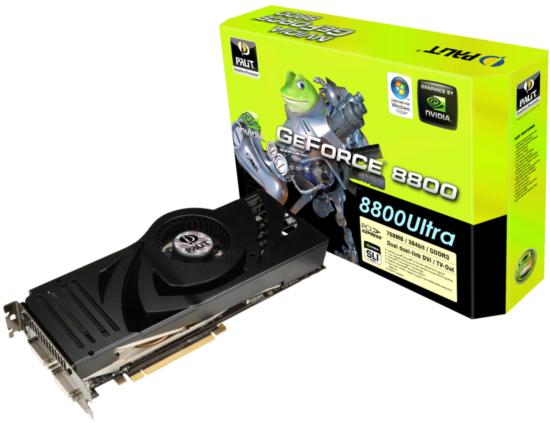GeForce 8800 ULTRA
Even before NVIDIA's official announcement of the GeForce 8800 Ultra, it was known that this high-end solution, designed to further strengthen the company's position in the premium consumer graphics card sector, would be an overclocked version of the GeForce 8800 GTX. No wonder: developing a more powerful GPU, even based on the G80, would be too slow and expensive, especially since video adapters of this class make up an insignificant share of the discrete desktop graphics market. In addition, NVIDIA has done this more than once: just remember the GeForce 7800 GTX 512, not to mention earlier solutions like the GeForce 2 Ultra or GeForce 3 Titanium 500.

So, it was initially clear that the GeForce 8800 Ultra would use the same graphics processor as its predecessor, the only question was the degree of overclocking, the possibility of using a new printed circuit board (as was the case with the GeForce 7800 GTX 512), the use of an improved cooling system, and perhaps installing fast GDDR-4 memory. The clock frequencies of the core were called about 650-700 MHz, memory - 2000 MHz and higher, as well as the price of about 9, but the situation gradually cleared up. It turned out that the GeForce 8800 Ultra will still use GDDR-3 memory with a total capacity of 768 MB, like the GeForce 8800 GTX, and the GPU frequency will be only 612 MHz for the main domain and 1.5 GHz for the shader processor domain - 6% and 11% growth compared to the GeForce 8800 GTX, respectively. The memory frequency has increased from the nominal 1800 MHz to 2160 MHz; according to this parameter, the novelty received the most solid increase.
Initially, the release of the GeForce 8800 Ultra was supposed to be a pre-emptive blow to AMD before it announced the R600 and cards based on it. Such a blow was actually dealt on May 2, somewhat later than the announcement of new mass solutions of mass solutions represented by the G84 and G86 chips. However, the performance gain turned out to be quite modest, from 2% to 14%. In addition, ATI decided to counterattack in other sectors, and NVIDIA's new product simply had no one to compete with - the Radeon HD 2900 XT with its price at level 9 became a direct rival of the GeForce 8800 GTS 640MB, a card belonging to a completely different price class.
Initially, the release of the GeForce 8800 Ultra was supposed to be a pre-emptive blow to AMD before it announced the R600 and cards based on it. Such a blow was actually dealt on May 2, somewhat later than the announcement of new mass solutions of mass solutions represented by the G84 and G86 chips. However, the performance gain turned out to be quite modest, from 2% to 14%. In addition, ATI decided to counterattack in other sectors, and NVIDIA's new product simply had no one to compete with - the Radeon HD 2900 XT with its price at level 9 became a direct rival of the GeForce 8800 GTS 640MB, a card belonging to a completely different price class.
Specifications NVIDIA GeForce 8800 ULTRA
| Name | GeForce 8800 ULTRA |
| Core | G80 |
| Process technology (µm) | 0.08 |
| Transistors (million) | 681 |
| Core frequency | 612 |
| Memory frequency (DDR) | 1080 (2160) |
| Bus and memory type | GDDR3 384 Bit |
| Bandwidth (Gb/s) | 103.7 |
| Unified shader blocks | 128 |
| Frequency of unified shader units | 1512 |
| TMU per conveyor | 32 (total) |
| ROP | 24 |
| textures per clock | 32 |
| textures per pass | 32 |
| Shader Model | 4.0 |
| Fill Rate (Mpix/s) | 14688 |
| Fill Rate (Mtex/s) | 19584 |
| DirectX | 10.0 |
| Anti-Aliasing (Max) | SS&MS - 16x |
| Anisotropic Filtering (Max) | 16x |
| Memory | 768 |
| Interface | PCI-E |
| RAMDAC | 2x400 |
In a certain sense, the GeForce 8800 Ultra was a disappointment - more was expected from NVIDIA, especially in light of the fact that many of the company's partners have been offering overclocked versions of the GeForce 8800 GTX for a long time, with parameters quite close to those of the new product. despite the inappropriateness of its release, this accelerator became the king of 3D graphics for a long time....
bioshock




